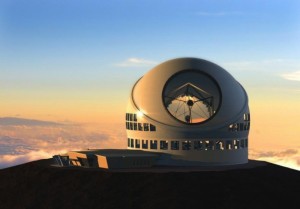Mauna Kea: A search for balance between sacred summit and science city
Posted by Wendy Osher
The University of Hawaii at Hilo submitted a final environmental impact statement for a proposed Thirty-Meter-Telescope (TMT) atop Mauna Kea on the island of Hawaii. The 376-page document was prepared to provide the public, stakeholders and decision makers with information on potential impacts of locating the project in Hawaii.
An ongoing issue is the importance of the summit in traditional Hawaiian culture and the challenges that have surfaced in utilizing the space for science.
The proposed TMT Observatory would house a 30-meter diameter mirror, making it the most capable ground-based telescope in the world. Supporters of the project say it would result in substantial benefits to the local and state economies.
Proposed Project and its objectives:
UH Hilo is seeking approval of a Conservation District Use Permit from the state Board of Land ad Natural Resources to allow a sublease to state land and the construction and operation of project components within the state’s Conservation District.
The proposed site is located on about five-acres of land near the 13,150 foot elevation, and a half mile northwest of the eight existing optical/infrared observatories located near the summit.
The location is considered preferable to the applicant because it provides “suitable observation conditions with minimum impact on existing facilities, Wekiu bug habitat, archaeology/historic sites, and viewplanes.”
In addition to helping the U.S. maintain its 150-year-long leadership position in astronomy and research, the project is also aimed at leveraging the capacity and abilities of existing astronomy facilities in Hawaii.
Another objective of the project is to advance fundamental questions about the nature, origins, and workings of the Universe. The project is also seen as an educational tool to attract students to the science and technology fields, as well as provide a platform in which partner institutions can integrate science, culture, sustainability and education.
Background of science development at Mauna Kea:
The first optical observatory was built on Mauna Kea in 1964 by the U.S. Air Force. Since then, that number has grown to a total of 11 observatories that occupy the summit region, employing more than 600 state and county workers. Supporters of the project say it also provides a teaching and research resource venue to the University of Hawaii.
At the time of the report, Mauna Kea attracted an estimated 240 visitors per day. With increased traffic and development a Mauna Kea Comprehensive Management Plan was established to provide a framework for managing current and potential future uses and activities within UH’s Management Areas on Mauna Kea. The CMP is designed to help UH in its efforts to protect and conserve Mauna Kea’s cultural and natural resources.
The cultural prospective:
Opponents to the project have argued against development saying the site is sacred. As the highest volcanic peak in the Hawaiian Islands, Mauna Kea is looked upon with great importance.
There are a total of 263 historic properties, including 141 ancient shrines identified within the Mauna Kea Science Reserve, according to the FEIS.
According to tradition, and documented within the FEIS, the “Kea” in Mauna Kea, is an abbreviation for Wakea, the great sky god, who together with Papa-hanau-moku, the Earth Mother, and various gods and natural forces, gave birth to the islands. The tradition further states that Hawaii Island was the first born and largest of the islands, with Mauna Kea known as “ka piko o ka moku” or the “navel of the island.”
The FEIS further recognizes the natural features of the landscape, such as the cindercones of the mountain, which were named in Hawaiian tradition after ancient ancestors, many of whom were regarded as gods and goddesses. Some of the most prominent among these include Poli’ahu, the goddess of the snows of Mauna Kea; Waiau, goddess of the lake; Lilinoe, the goddess of the mist; and Kukahau’ula, the husband of Lilinoe.
According to the document, tradition tells that access to the summit was limited to high chiefs and priests, where prayers could be offered in the utmost reverence. The sacred zone next to the Kuahiwi is known as Kualono, where adze makers came from as early as AD 1100 through the 1700s, the document said.
As part of the ritual associated with quarrying, the document state, craftsmen erected shrines. The two uppermost sacred zones were also used for burials, according to the report, with one pu’u or cinder cone, having been confirmed to contain burials and four others considered likely to contain burials.
Beneath the summit there are four additional zones described: wao ma’u kele, a wet area of large koa; wao akua, an area of more varied forest where good and bad spirits lived and people did not; wao kanaka, the lowest forested area most used as a cultural resource; and kula, the upland grassy plains.








_1709057595069.webp)


